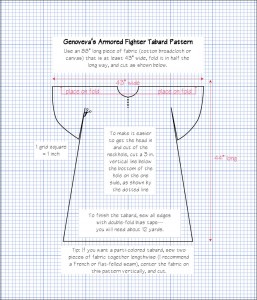A new member of my group recently asked how to make a tabard. This got me thinking. The tabards I’ve made have been pretty generic, as many others who came before me have already done a good job of covering tabard construction throughout history. I’m fond of the tabard pattern I use — it’s adapted from Duke Dag’s design, and it looks great over armor and while fighting, giving free range of arm movement. If you’re interested in that tabard, here is the pattern as a PDF and as a simple JPG (click the image below for a larger view).
Note that the above tabard pattern is based on my guy Gregor’s 6’2″ frame. If you’re smaller, you should narrow and shorten it appropriately.
But I began to wonder — what would a German Renaissance tabard look like? It doesn’t appear the Landsknecht soldiers wore tabards at all, based upon a review of woodcuts. They did wear leather vests, called ledergoller, which one might confuse with a tabard, but they did not have the same function as far as I can tell. Nonetheless, tabards were useful with armored combat because they served as easy identification on the field and because they hid problems in armor, making it less likely your enemy might notice a spot less defended, so it’s likely they were worn by some Germans in battle, though perhaps not many.
I have found evidence of herald’s tabards in Germany in the 16th century, however. One in particular, a Heroldsrock from Bayerisches Nationalmuseum, is dated to the 16th century. It looks like a surcoat with long sleeves, and less like the tabard that we know. There is another tabard worn by the herald of the Holy Roman Empire which looks more like a tabard, but is elaborately embroidered. The most familiar looking tabards I’ve found is on another German herald depicted in a 1555 book, Ehrenspiegel des Hauses Österreich — a heraldic symbol tabard, a diagonally striped tabard , and a more elaborate tabard with tassels. And then there is an illustration of Joerg Rugenn in a tabard, found in the Oesterreichesche Nationalbibliothek (Austrian National Library) Cod. 2936, Part 2, fol 11v), and shown on the left.




Thank you for this wonderful idea and pattern base. This may become useful in the future I’m sure.